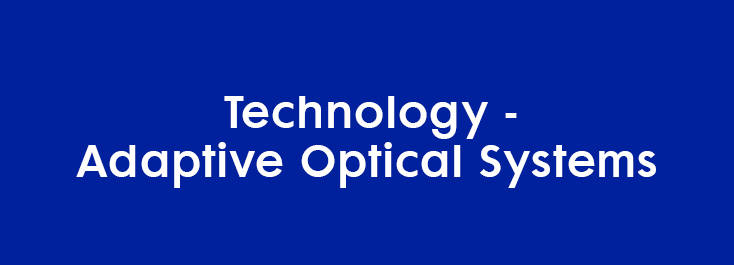Adaptive Optical (AO) Systems
Adaptive optics have been integrated into systems for beam propagation, communications and microscopy. The traditional usage for AO was to correct for atmospheric turbulence during astronomical imaging. An incoming distorted wavefront is reflected off a Deformable Mirror (DM). After reflection, a fraction of the beam is split off and passed to a WaveFront Sensor (WFS). The WFS produces a 2D map of the distortions of the wavefront. These measurements are then used to generate the drive signals for the DM actuators. The system forms a closed loop driving the wavefront entering the WFS to null (flat). The flat wavefront will form a perfect diffraction limited image of the source.

Schematic of Traditional AO System
Deformable Mirror (DM)
A DM is a mirror whose surface shape can be accurately controlled via some method of actuation to control wavefront phase. AOA Xinetics is a leading provider of DMs, particularly for space and directed energy applications.
Wavefront Sensor (WFS)
A WFS measures the phase of an optical wavefront. A typical AO system uses a Shack-Hartmann WFS since these tend to have fast update rates and are less sensitive to environmental perturbations than other wavefront sensing methods. A reconstructor matrix is a mathematical object that converts data from the WFS into command signals to the DM. This matrix is usually determined by a calibration process. AOA Xinetics is a leading provider of custom wavefront sensors.
Driver Electronics
Deformable mirrors based on PMN technology, like those offered by AOA Xinetics, require high voltages to exercise the actuators. A mirror driver is an electronic device that converts signals from a computer processor into high voltage currents that are sent to the DM. Each actuator of the DM must have its own high voltage channel and corresponding physical wiring. AOA Xinetics offers the GEN III driver with up to 480 output channels.
Sensorless AO
Sensorless AO refers to a system without an explicit wavefront sensor, instead using the imaging camera as the detector that guides the shape of the DM. It is a catch-all term for "hill-climbing" techniques implemented by the direct optimization of a system performance metric applied through an active optical component. A specific example is Stochastic Parallel Gradient Descent (SPGD). Control is based on the maximization of system performance metric by small adjustments in actuator displacement in the mirror array, for instance the maximization of power through a pinhole. Sensorless AO techniques are less complex, less costly and more compact than traditional AO systems. However they tend to have poorer bandwidth and may not converge under certain circumstances. AOA Xinetics has direct experience with a variety of sensorless algorithms, including SPGD, phase diversity, and modal image optimization.
Processor and Software
Adaptive optics can be computationally intensive if the DM actuator count is numerous. Since wavefront measurement resolution depends on high density there is continuous pressure to increase the number of actuators. Adding to the processing burden is the requirement for temporal bandwidth fast enough to correct for atmospheric turbulence. The actual frame rate of the AO system must be many times higher than the bandwidth of the disturbance. AOA Xinetics has deep experience with minimizing the latency in computer hardware and developing efficient algorithms to maximize bandwidth.

Standard resolution target imaged during AO system lab checkout

Flattened DM wavefront < 15 nm (RMS)
Field testing a beaconless AO System
Multi-Conjugate Adaptive Optics (MCAO)
Jankevics and Wirth, both still active at AOA Xinetics, were one of the first to describe in technical detail how to implement an MCAO system for wide-field-of-view adaptive optics. (Proc. SPIE 1543, Active and Adaptive Optical Components, 438 (January 13, 1992)). One limitation of traditional atmospheric compensation systems is the small field-of-view (FOV) over which the correction improves wavefront quality. A wavefront sensor measures the aberrations accumulated along the path from the object point centered in the FOV, but light coming from a nearby object point will take a slightly different path through the atmosphere and thus accumulate somewhat different aberrations. Multi-Conjugate Adaptive Optics (MCAO) can extend the FOV by the use of two or more correction elements (deformable mirrors) that are optically conjugate to different layers of the turbulent path. This introduces an angular dependence into the correction that is applied, which can be made to mimic the variation of the aberrations with field angle. The process is very similar to tomography, in which a three dimensional model of an object is derived from observations at many angles through the object.

Depiction of Isoplanatic Angle


